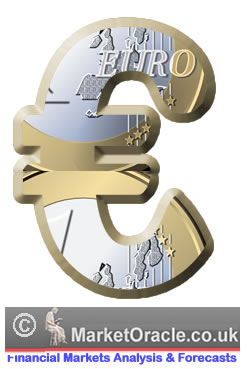Euro Rally Profit Selling Opportunity
Currencies / Euro Jul 11, 2010 - 02:58 AM GMTBy: Bryan_Rich
 Over the past month, the talk from European officials about the sovereign debt crisis has gone relatively quiet.
Over the past month, the talk from European officials about the sovereign debt crisis has gone relatively quiet.
Meanwhile, the euro has bounced aggressively from 1.1877 to over 1.27 versus the dollar.
It’s important to note that markets around the world have taken cues from the direction of the euro as a proxy for Europe’s health. So it’s no surprise that a rising euro has consequently driven the recent bounce in global stocks and commodities — even in the face of deteriorating economic data.
So why has the euro risen?
Is the euro telling us all is well on the sovereign debt front? Or, at least, that all is not as bad as many might have believed?
Not likely.
What’s more likely is that a rise in the euro is part of another G-20 public relations campaign.
The goal:
Persuade, Influence and Stabilize Global Confidence
Without confidence … credit seizes, consumers batten down the hatches and the financial system wobbles.
 |
| Europe is on a massive PR campaign to pump up confidence in the euro. |
Just this week, the IMF made an upward revision to its global growth forecast for 2010 to 4.5 percent from 4 percent in April, with one major caveat … that Europe can implement policies to “rebuild confidence and stability.”
Of course, Europe has already rolled out a $1 trillion “stabilization mechanism” to restore confidence. And they will follow in the coming weeks with a not so stressful stress test on European banks.
Given these tests are for public consumption — part of the PR campaign — it’s safe to assume the results of the test will be favorable. But such persuasion tactics don’t typically work in an unforgiving currency market.
So what’s driving the euro higher?
The finance ministers and central bankers of the top 20 countries in the world gathered in Korea on Friday, June 4. They left with the message of “securing global recovery, and addressing economic challenges and risks.”
By coincidence or not, the following Monday the euro bottomed and proceeded to jump 5 percent in just ten trading days. And it has continued its climb, even on days when global stocks, commodities and nearly all other currencies were falling!
On top of that, there is the rising probability of a double-dip recession for major economies.
Indeed … a stark contrast to typical behavior of a currency that’s extremely vulnerable to more pain ahead.
 |
| Despite the massive propping up by the IMF and other emu members, Greek bond yields are soaring. |
Meanwhile, beyond the PR, developments surrounding sovereign debt problems in Europe and the structural problems of the European monetary union haven’t changed one bit.
Market Health: Perception and Reality
The $1 trillion stabilization mechanism put together by Europe has not been able to reduce the fears of a Greek default. In fact, Greek borrowing costs are climbing sharply back toward levels not seen since Europe/IMF made the massive backstop promises!
And recently, Moody’s placed top-rated Spain on review for a downgrade. The concerns they list fit the bill for many euro-zone members …
- Deteriorating economic growth prospects,
- Challenges government faces in achieving fiscal targets,
- And concerns over the impact of rising funding costs.
Plus, Spain’s saving banks are said to be in trouble, reported to be hiding non-performing loans.
Given all of this, who in the world would be buying euros?
Well don’t forget, a rising euro in the current economic environment can positively influence perception. And that reality has been effective in calming some turbulent waters in the greater financial markets.
That’s why I think China, the holder of the largest stash of currency reserves in the world, is the most likely buyer. And I’m not alone …
A highly respected think tank noted that its “well placed sources” said in early June that China has been and will be buying euros to make sure the decline in the euro is orderly.
Europe is China’s biggest trading partner. Therefore, it’s clearly in China’s best interest not to see Europe unravel. At the same time, Europe needs a weaker euro to revalue its debt and stimulate exports.
So expect the euro to go much lower, which is why this euro rally represents a selling opportunity.

The above chart shows the seven-month downtrend in the euro. And the red trendline should prove formidable resistance for this bounce. That should give you an attractive place to build or add exposure to a weaker euro going forward.
Regards,
Bryan
P.S. I’ve been showing my World Currency Alert subscribers how to use exchange traded funds to protect their wealth and profit … as currencies rise and fall. If you’re not a subscriber, you can check it out by clicking here.
This investment news is brought to you by Money and Markets. Money and Markets is a free daily investment newsletter from Martin D. Weiss and Weiss Research analysts offering the latest investing news and financial insights for the stock market, including tips and advice on investing in gold, energy and oil. Dr. Weiss is a leader in the fields of investing, interest rates, financial safety and economic forecasting. To view archives or subscribe, visit http://www.moneyandmarkets.com.
© 2005-2022 http://www.MarketOracle.co.uk - The Market Oracle is a FREE Daily Financial Markets Analysis & Forecasting online publication.



